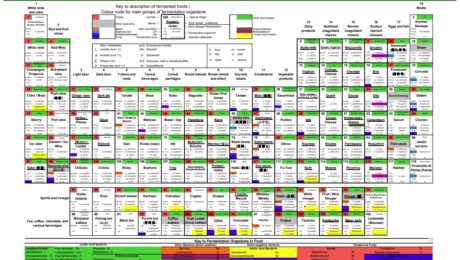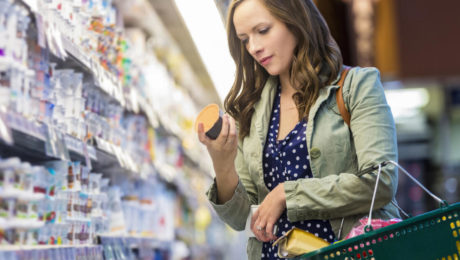Beauty Embraces Bacteria
Beauty brands continue to capitalize on a trend: putting prebiotics, probiotics and postbiotics into skin-care products. This “wave of new products” that tout -biotics is filling the cosmetic aisle, according to The New York Times.
“It’s like ‘Star Wars’ happening on the surface of skin,” says Dahlia Devkota, founder of the Los Angeles-based skin-care brand Editrix. “‘Good’ and ‘bad’ bacteria both excrete postbiotics, which are their weapons of war. The goal is a balance of both with no one species taking over.”
Devkota adds that she finds skin care products with -biotics are gentler on the skin. Many traditional skin-care brands strip the skin of natural oils, “weaken(ing) the skin barrier.”
Some brands are experimenting with using fermented ingredients in their skin care products. Venn, another Los Angeles-based skin-care brand, has a scientific advisory board that has spent decades studying the microbiome. Venn’s Synbiotic Defense Mist face spray uses water with probiotic ferments.
“Because fermentation makes the molecules smaller, the product can penetrate the skin surface more deeply,” says Jeff Rosevear, the head of skin-care research and development for new brands at Unilever. The company’s new line, Ferver, has a serum made with fermented collagen.
Read more (The New York Times)
The “Tip of the Iceberg” of Fermented Foods
There’s a huge amount scientists worldwide still need to learn about fermented foods. “We’re really at the tip of the iceberg, as far as I’m concerned,” says Paul Cotter, professor and head of Biosciences at Teagasc Ireland.
“If you think of the vast variety of fermented foods from all across the globe – from East Asia, from Africa, from South America – we really haven’t studied these in any great degree at all, maybe some very basic study, but no microbiome analysis,” Cotter continues. “So really not fully appreciating what’s in there or really harnessing those foods for broader society.”
Cotter, Bruno Pot (science director at Yakult Europe) and Maciej Krol (founder of mac.ferments) discussed fermented foods at a panel at this year’s Probiota conference in Copenhagen. In an interview with NutraIngredients – which wrote “fermented foods took center stage” at the conference – Cotter and Pot discussed the opportunities and challenges of fermented foods.
Expanding the Study of Fermented Foods
Modern technology continues to advance, allowing DNA sequencing and complex analysis of food. It’s of “critical importance” that we further study fermented foods, Cotter adds.
For example, there have been numerous randomized controlled trials with dairy kefir that confirm health benefits. But the results were shown to be dependent on the probiotic strains used – one could help reduce cholesterol, while another would address the gut-brain axis.
“If you don’t happen to have the right one in your kitchen, you’re not benefiting from it,” he says. “By carrying out in-depth investigations of the microbiomes and the metabolites that they produce, you can get a better sense as to what foods have the right microbes for you and to make almost a personalized type of fermented food for each person.”
Cotter stresses studying the foods individually rather than fermentation as a whole. There are specific foods, unique to a country or culture and produced on a small scale, “that we know very little about and might have fantastic health attributes.” He fears that, if these foods aren’t studied, the populations that traditionally make them will die off or move, and their approaches to making these foods will be lost.
Dietary Microbes
Pot points to the fact that non-communicable – “New Age” – diseases emerged and began to increase as food production became more commercialized.
“We need to promote (the) intake of live microorganisms,” Pot says. The public needs to be told “how important it is to maintain healthy conditions in their gut.”
Pot is pushing for a microbes category to be included in dietary recommendations. A late 2020 study published in The Journal of Nutrition officially introduced the idea that a daily intake of microbes could improve health. He compares it to the definition of dietary, which helps educate the public about the kinds of fiber important in a healthy diet.
“The purpose of creating a category is really to allow easier communication with the consumer about the importance of live microorganisms in the diet,” Pot says. “The creation of this category will be a first step.”
Any recommendations, he adds, must be based in science. But it can be challenging to try to educate consumers about often complex scientific topics. It’s important for messaging to be simple, Cotter adds.
“Unless you have a means of explaining to the consumer what are these benefits, then you’re running into great difficulty,” he says.
Today, the public is more conscious today of immune health, and views fermented foods as natural and functional. Cotter believes, if it can be scientifically proven that dietary microbes should be consumed daily, legislators and regulators will add it to dietary guidelines.
Artisanal vs. Large Scale
Cotter sees the future of fermented foods tied to compromise between large- and small-scale producers. Industrialized ferments need to be tweaked to more closely resemble artisanal foods, while artisanal products need to become more readily available to the public at large.
“Fermented foods are quite often very healthy, but the health benefits aren’t fully appreciated because they haven’t been studied in great depth,” he says. “Typically, when those foods have been converted to make them on a large scale by an industry for production to try to make a product that’s available to as many people as possible, the microbiology of the food is very much simplified.”
On the other hand, it’s challenging to “harness the health benefits associated with artisanal foods” when a small brand scales up.
“I think there’s an opportunity for the two to meet in the middle,” Cotter says. “Retain artisanal qualities associated with food but make them available to as many people as possible for mass production.”
Fermented Foods Face Patchwork of Global Regulation & Standards
Should there be global standards for fermented foods? A new study argues “to preserve consumer confidence in fermented foods,” uniform regulations are needed.
Current guidelines “are not mature enough to adequately regulate the significant diversity of fermented foods that are increasingly available in the market,” reads the study, published in the peer-reviewed journal Frontiers in Nutrition. While fermented foods are experiencing a major resurgence in popularity, standards and regulations differ by country and – in some instances – region and state. Fermentation regulations are few and, in the case of some foods, nonexistent.
Scientists at Teagasc, Ireland (the agriculture and food authority in Ireland) studied regulations in North America, South America, Asia, Africa, Europe and Australia/New Zealand. Their research – supported by the Institute for the Advancement of Food and Nutrition Sciences (IAFNS) – is thorough. They found legislative efforts to regulate or standardize fermented foods “have been largely reactive, rather than being proactive, in nature.”
A harmonized blueprint, the study continues, would include specifics for each fermented food, not just the category. Uniform standards would include:
- Microbial and chemical composition
- Safety protocols
- Standards on storage, transportation and distribution
- Communication guidelines
- Regulatory clarity
- Government expert committee oversight
“Ultimately, addressing the challenges outlined here, would contribute to the ease of doing business, encourage consumer and investor confidence, leading to growth and innovation in this category, which in turn will catalyse overall economic progress,” the study reads.
There is also a need for a uniform regulatory framework because there is “…a visible lack of consideration of insights gained from the large corpus of microbiome studies on FFs and their microbial composition in corresponding global Food Standards or Codes.”
There is currently a Codex Alimentarius or “Food Code” by the Codex Alimentarius Commission, part of the Food Standards Programme for the United Nations Food and Agriculture Organization (FAO) and the World Health Organization (WHO). But fermented foods are not extensively represented. Regional standards have also been established by FAO and WHO, but these are generally for traditional fermented foods and beverages consumed only in certain regions, not widely used elsewhere.
The study points to South Korea and India as examples. Both countries have consolidated standards and specifications on fermented foods into legislation.
Marketing Gut Health
Consumers want foods that aid gut health, but brands face a major challenge. How can they educate buyers about microbiome health benefits without getting into trouble with regulators?
“It’s no longer enough to just say ‘healthy,’” says Alon Chen, CEO and co-founder of Tastewise, an “AI platform for food brands.” “We are absolutely more critical of health claims in general. We want to know how, we want to know why and we want it backed by science.”
The term “healthy” is no longer resonating with consumers. Over 30% are looking for products with multifunctional benefits, according to research by Tastewise. They want more detail, on topics such as gut health, sleep improvement, brain function, anti-bloating and energy.
“Food is no longer just about nutrition, nor is it about general health,” says Flora Southey, editor at Food Navigator. “Consumers want more from the food they consume – and they want to be specific about it.”
What are the challenges and opportunities for brands trying to deliver gut health? A panel of food and nutrition experts tackled the issue during a Food Navigator webinar: “From Fermentation to Fortification: How is Industry Supporting Gut Health and Immunity?” Here are highlights.
Regulation Woes
There are trillions of microbes in our gut, but science has only scratched the surface of their power. Gut health is an ambiguous – and often confusing – subject for consumers.
Regulations on gut health claims are evolving. A year ago, the European Food Standard Authority asked food producers to help evaluate microbiome-based product claims.
“In order for us to assert ourselves in the industry, we have to be able to defend and support these claims,” says Anthony Finbow, CEO of Eagle Genomics, a software company incorporating microbiome research into their data analysis.
It’s “the dawn of a new age,” according to Finbow. Major food companies are now valued for delivering nutrition in addition to caloric content. “There is greater consumer understanding that food is a mechanism for better health.”
Southey feels brands need to do more for consumer education “I’m not convinced [the message is] getting to the consumer as well as it should be.”
Nutrition drink brand MOJU is attempting to tackle the regulatory stumbling block of health benefits on a label. Strict rules requiring detailed substantiation have resulted in few gut health claims“We’ve got a long way to go from an education point of view,” says Ross Austen, research and nutrition lead at MOJU.
MOJU can’t use the term “gut health,” but they can say a drink contains vitamin C or D, which have been proven to boost the immune system. They can’t say their drink is anti-inflammatory, but they can say it contains turmeric, known for its anti-inflammatory properties.
Marketing -Biotics
More consumers want the presumed gut health benefits of probiotics, prebiotics and postbiotics to power their microbiome. Probiotics “have largely stolen the headlines over the past few years,” Austen says, but prebiotics are appearing in more and more products. MOJU puts prebiotic fiber in their drinks because probiotics are a challenge for packaged food products. Because probiotics contain live and active cultures, they must be refrigerated and their efficacy tested.
Ashok Dubey, Phd, senior scientist and lead for nutrition sciences at TATA Chemicals (a supplier of chemical ingredients to food and drink producers), agrees. Dubey feels that the benefits of probiotics have been diminished in the minds of consumers. He notes that when probiotics first began appearing in foods 20 years ago, they were claimed to be able to solve any and all health ailments.
“There’s a greater understanding that our gut microbiota is so complex, if the food we eat is so complex, then the solution we should provide should be a combination of all of this,” he says. Dubey is seeing more patents combining probiotics and prebiotics, a complex solution that he says looks at whole health.
But, he notes, any claim with -biotics must be validated by scientific research.
Traditional Foods vs. Clinical Trials
Hannah Crum, president of Kombucha Brewers International (KBI), takes issue with the need to validate every health claim with scientific research. “We shouldn’t displace a huge body of traditional knowledge in favor of pharmaceuticals,” she says.
Making health claims around -biotics has been challenging for the kombucha industry. “It doesn’t honor what food does for us nutritionally,” she adds. Today’s food industry is so heavily regulated that foods traditionally consumed by humans for centuries – like kombucha – can’t put a health claim on a label without proving benefits in a human clincal trial.
“It’s frustrating,” Crum says. ““In fact, because there is no definition of the word probiotic from a legal perspective, it leaves our brands vulnerable to be attacked by parasitic lawyers who just want to extract value from large corporations because they can.”
“In my opinion, we need to honor the fact that all traditionally fermented foods are probiotic by nature instead of saying ‘Well you need the research to prove it,’” she says.
Fermented Blackberry’s Anti-Wrinkle Power
A new study found ingesting fermented blackberries wards off wrinkles, increasing collagen and skin thickness.
Researchers tested the effects on Korean adults – between the ages of 35 and 60 – over a period of 12 weeks . The blackberries – fermented with lactic acid bacteria – were found to significantly decrease wrinkles around the eyes.
The results, published in the journal Cosmetics, are a follow-up to a clinical trial on the formula (known as BB-1000) in mice.
“The significance of this study is that the anti-wrinkle efficacy of a fermented blackberry product was confirmed not only in previous animal experiments but also in this clinical trial.” As a result of clinical trials on skin wrinkle improvement and safety, BB-1000 is expected to be used with confidence as a healthy functional food that can improve skin wrinkles.”
Read more (Molecules)
- Published in Science
The “Periodic Table” of Fermented Foods
A pioneering “periodic table” of fermented foods was released this month, the first attempt to represent the breadth and range of fermented foods and beverages in graphic form.
This creation is the brainchild of Michael Gänzle, PhD, professor and Canada Research Chair in Food Microbiology and Probiotics at the University of Alberta. Gänzle is regarded as an expert in fermented foods and lactic acid bacteria. His recent research includes identifying a new taxonomy for the lactobacillus genus, a topic Gänzle spoke about in a TFA webinar.
“Non-traditional fermented foods are a big trend both in industrial food production and in culinary arts,” Gänzle said in an interview with TFA. “The periodic table may be the most concise overview on what is possible if all of the diversity of our benign and beneficial microbial helpers is recruited.”
The impetus for the table dates to 2014, when Gänzle and a colleague used a periodic table of beer styles in their food fermentation class. They wondered if it would be feasible to create a similar version for fermented foods.
Gänzle’s final version, along with his well-documented analysis of the table, was published in the journal Applied Microbiology and Biotechnology. The table includes 118 entries of fermented foods, each coded for product category, country of origin, fermentation organism (like LAB, acetic acid bacteria or yeasts), fermentation substrate, metabolites and fermentation time.
Gänzle suggests the table is “quite useful for a number of things that may impact the development of fermented foods.” He says fermentation has “reemerged as a method to provide high-quality food.” A chef or producer can use the table to compare “differences and similarities in the assembly of microbial communities in different fermentations, differences in the global preferences for food fermentation, the link between microbial diversity, fermentation time and product properties, and opportunities of using traditional food fermentations as templates for development of new products.”
Because of its straightforward graphical layout, the table can quickly answer questions. A scan of it shows “which foods contain live fermentation microbes, which regions of the world have which preferences for substrates and fermented foods, which fermented foods are back-slopped and are fermented with host-adapted fermentation organisms.”
He stresses, though, that the table has its limitations, as it doesn’t cover every fermented food.
“The more I read the more likely I am to quote Plato’s rendition of Socrates’ statement that ‘I neither know nor think I know,’” Gänzle says. “Fermented foods are about as diverse as humankind.”
Gänzle plans to continue to revise the table on his personal website. Currently, he and two doctoral students are researching fermented soy and legumes, so look for the next updates to be in those categories.
- Published in Science
LAB Makes Sour Cream Healthier
Adding fermented pickles to sour cream increases the health benefits of the cream, lowering cholesterol and increasing antioxidant properties, according to new research.
Scientists from the Poznań University of Life Sciences in Poland based their research on the French paradox, “the observation that… reduced heart disease is associated with a diet high in saturated fat and cholesterol.” They picked sour cream because of its high levels of saturated fat and cholesterol.
“The results also show that the health-promoting potential of sour cream is enhanced by the presence of metabolically active LAB,” continues the study, published in the Journal of Dairy Science.
The scientists note future work will revolve around characterizing the properties of specific lactic acid bacteria produced by spontaneous fermentation.
Read more (Medical and Life Sciences)
A Nutrition Pro’s Fermentation Guide
Nutrition professionals need to share the details when recommending fermented products to clients. What are the health benefits of the specific food or beverage ? Does the product contain probiotics? Live microbes?
“There are a vast array of fermented foods. This is important because it means there can be tasty, culturally appropriate options for everyone,” says Hannah Holscher, PhD and registered dietitian (RD). But, she adds, remember that these are complex products.
Holscher spoke at a webinar produced by the International Scientific Association for Probiotics and Prebiotics (ISAPP) and Today’s Dietitian. Joined by Jennifer Burton, RD and licensed dietitian/nutritionist (LDN), the two addressed the topic Fermented Foods and Health — Does Today’s Science Support Yesterday’s Tradition? Hosted by Mary Ellen Sanders, executive director of ISAPP, the presentation touched on the foundational elements of fermented foods, their differences from probiotics, the role of microbes in fermentation, current scientific evidence supporting health claims and how to help clients incorporate fermented foods in their diets.
Sanders called fermented foods “one of today’s hottest food categories.” Today’s Dietitian surveys show they are a top interest to dietitians, as the general public often turns to them with questions about fermented foods and digestive health.
Here are three factors highlighted in the webinar that dietitians should consider before recommending fermented foods and beverages.
Does It Contain Live Microbes?
Fermentation is a metabolic process – microorganisms convert food components into other substances.
In the past decade, scientists have applied genomic sequencing to the microbial communities in fermented foods. They’ve found there’s not just one microbe involved in fermentation, Holscher explained, there may be many. The most common microbes in fermented foods are streptococcus, lactobacillaceae, lactococcus and saccharomyces.
But deciphering which fermented food or beverages contains live microbes can be difficult.
Live microorganisms are present in foods like yogurt, miso, fermented vegetables and many kombuchas. But they are absent in foods that were fermented then heat-treated through baking and pasteurization (like bread, soy sauce, most vinegars and some kombucha). They’re also absent in fermented products that are filtered (most wine and beers) or roasted (coffee and cacao). And there are foods that are mistakenly considered fermented but are not, like chemically-leavened bread, vegetables pickled in vinegar and non-fermented cured meats and fish.
“The main take-home message is that it’s not always easy to tell if a food is a fermented food or not. So you may need to do more digging, either by reading the label more carefully or potentially contacting the food manufacturer,” Holscher said. “When we just think of if live microbes are present or not, a good rule of thumb is if that food is on the shelf at your grocery store, it’s very likely that it does not contain live microbes.”
Does It Contain Probiotics?
The dietitians stressed: probiotics are not the same as fermented foods.
“Probiotics are researched as to the strains and the dosages to be able to connect consumption of a probiotic to a health outcome,” Holscher said. “These strains are taxonomically defined, they’ve been sequenced, we know what these microorganisms can do. They also have to be provided in doses of adequate amounts of the live microbes so foods and supplements are sources of probiotics.”
Though fermented foods can be a source of probiotics, Holscher notes: “In most fermented foods, we don’t know the strain level designation.”
“For most of the microbes in fermented foods, we’ve just really been doing the genomic sequencing of those over the last 10 years and so we may only know them to the genus level right,” she said. For example, we know lactic acid bacteria are present in kimchi and sauerkraut.
Holscher suggests, if a client has a specific health need, a probiotic strain should be recommended based on its evidence-based benefits. For example, the probiotic strain saccharomyces boulardii is known to help prevent travel-related diarrhea, and so would be good for a patient to take before a trip.
“If you’re looking to support health and just in general, fermented foods are a great way to go,” Holscher says.
The speakers recommended looking for probiotic foods in the Functional Food Section of the U.S. Probiotic Guide.
Does Research Support Health Claims?
Fermentation contributes to the functional and nutritional characteristics of foods and beverages. Fermented foods can: inhibit pathogens and food spoilage microbes, improve digestibility, increase vitamins and bioactives in food, remove or reduce toxic substances or anti-nutrients in food and have health benefits.
But research into fermented foods has been minimal, mostly limited to fermented dairy. Dietitians should be careful making strong recommendations based on health claims unless those claims are supported by research. And food labels should always be scrutinized.
“There’s a lot of voices out there that are trying to answer this question [Are fermented foods good for us?],” says Burton. “Many food manufacturers have published health claims on their labels talking about these benefits and, while those claims are regulated, they’re not always enforced. Just because it has a food health claim on it, that claim may not be evidence-based. There’s a lot of anecdotal accounts of benefits coming from eating fermented foods and the research is suggesting some exciting potential mechanisms. But overall we know as dietitians we have an ethical responsibility to practice on the basis of sound evidence and to not make strong recommendations if those are not yet supported by research.”
Reputable health claims are documented in randomized control trials. But only “possible benefits” can be linked to nonrandomized controlled trials. And non-controlled trials are the least conclusive studies of all.
For example, Burton puts miso in the “possible benefits” category because, with its high sodium content, there’s not enough research indicating it’s safe for patients with heart disease. Similarly, she does not recommend kombucha because of its extremely limited clinical research and evidence.
“We have to use caution in making these recommendations,” Burton says.
This is why Burton advises dietitians to be as specific as possible. Don’t just tell patients “eat fermented foods” — list the type of fermented food and its brand name. She also says to give patients the “why” — what is the benefit of this fermented food? Does it increase fiber or boost bioavailability of nutrients?
“Are fermented foods good for us? It’s safe to say yes,” Burton says. “There’s a lot that we don’t know, but the body of evidence suggests that fermentation can improve the beneficial properties of a food.”
Are -Biotics Becoming a Diluted Claim?
More and more food and beverages are labeling their product with -biotics – probiotics, prebiotics and postbiotics — confusing consumers as to what a -biotic is and its potential health benefit.
There’s an “overuse of the term probiotic as referring to any live microbe,” says Bob Hutkins, professor of food microbiology and the University of Nebraska (and a Science Advisor on TFA’s Advisory Board). Probiotics, according to the International Scientific Association of Probiotics and Prebiotics (ISAPP), require documentation of both a health benefit and the strain.
“It’s a high bar to call something a probiotic,” he continues. “I read labels that say ‘contains probiotics’ and I’d say, the vast majority of the time, they’re incorrectly named if they’re named at all.”
Hutkins was part of a panel hosted by Food Navigator on “Feeding the Gut Microbiome: From Pre-, Pro-, and Postbiotics.” Speakers included leaders of food brands and -biotic supplement brands.
Is a Fermented Food Probiotic?
The issues surrounding probiotics and fermented foods have long been debated. TFA hosted a webinar on the topic in 2021, and it was the focus of a keynote session at TFA’s FERMENTATION 2021 conference.
Using the example of kimchi, Hutkins explains the fermented cabbage may contain live microbes that closely resemble a probiotic strain. But, according to scientific-backed definitions by ISAPP and the World Health Organization (WHO), “you can’t call that kimchi probiotic unless you isolated the strain, characterized the strain, done a clinical study and then that kimchi is going to be different from the kimchi you’ll make tomorrow. So it’s a challenge for companies that are producing fermented foods that probably have live microbes that can provide some benefits, but you can’t call them probiotics.”
Hutkins encourages fermentation producers to use the term “rich in live microbes” on their label instead. If the product does include clinically tested probiotics (like in yogurt), “I really applaud the company that puts the genus and species on their package.”
Consumer Education
Miguel Freitas, PhD, vice president of health scientific affairs at Danone North America, says the conversation in the industry needs to change from just probiotics to strain specificity.
“There are many consumers that are just seeking the word probiotic on the packaging. And they believe that probiotics will [help] everything from immune health to gut health,” Freitas says. “This is where I believe it can start to get tricky because there are so many products out there.”
Though the science around -biotics has evolved tremendously in the past two decades, consumers are overwhelmed and confused by all the choices.For example, he points to a new clothing brand that alleges the probiotics in their clothes are activated by heat.
This is why the food and beverage industry needs to play an active role in consumer education, says Todd Beckman, president of Verb Biotics.
“They have a platform to talk about health, these specific ingredients and health benefits,” he says. “They have the megaphone to talk to consumers in a true and authentic way.”
But Beckman warns: “the brands that don’t really know what they’re doing or don’t stand for anything or don’t stand for science, they’re not going to be there tomorrow.” Consumers will abandon brands with unsubstantiated health claims.
“If all of a sudden consumers aren’t believing in probiotics or what they can do, then it’s quite damaging,” he says.
Tom First, founder and CEO of Culture Pop probiotic soda, says that, though their brand has the clinical benefits of a verified and shelf-stable probiotic strain, they don’t lead with this complicated information in their marketing. Instead, they focus on flavor and it “being a fun drink,” figuring consumers can look to the Culture Pop website if they want to dive deeper.
Assorted -Biotics
Adding to consumer confusion: products on grocery shelves may now contain one of three -biotics – probiotics, prebiotics or postbiotics. Justin Green, PhD, director of scientific affairs at Cargill Health Technologies, says many think of -biotics as a daily supplement with a simple health benefit, like vitamin C.
“We really have to drive home there’s going to be different [-biotics] from different organisms, different fermentation techniques and most importantly different health benefits,” he says.
Probiotics are live bacteria; prebiotics are food for the bacteria; and postbiotics are metabolites produced by the probiotics.










